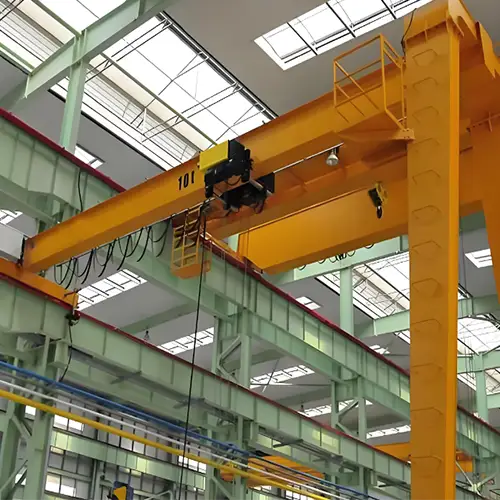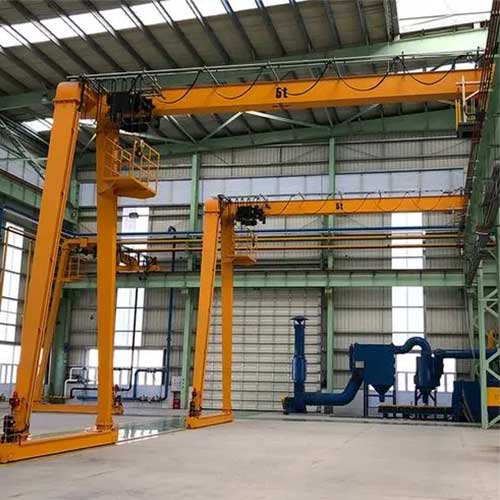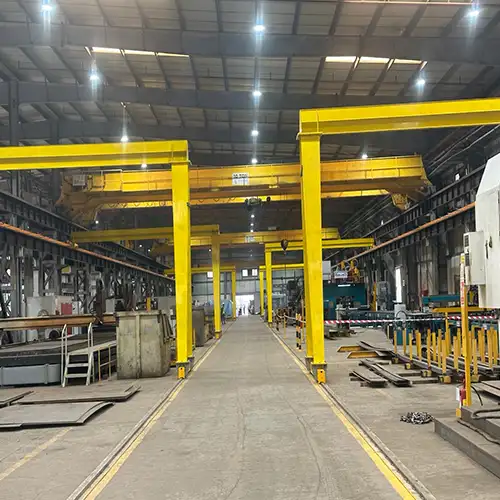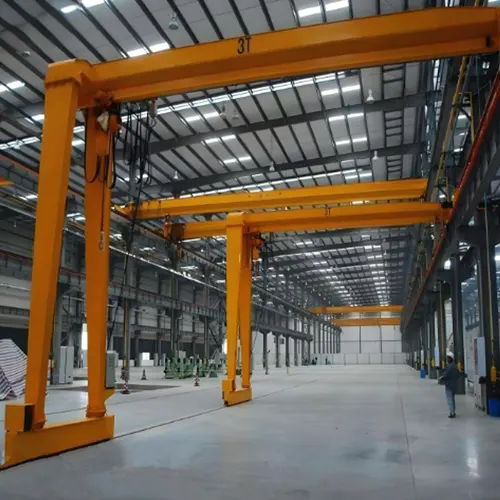Comprehensive Capacity Analysis of Semi-Gantry Cranes Explained
Evaluating semi-gantry crane capacities for efficient load handling, including weight, size, and operational constraints.
Category: Full& Half Gantry
Your Trusted Semi Gantry Crane Manufacturer & Supplier
Comprehensive Capacity Analysis of Semi-Gantry Cranes Explained
Evaluating semi-gantry crane capacities for efficient load handling, including weight, size, and operational constraints.
Overview of Semi-Gantry Cranes
Semi-gantry cranes are versatile lifting solutions designed for efficient material handling in various industrial settings. Unlike traditional gantry cranes, semi-gantry cranes feature a single support leg and a fixed leg, which allows them to straddle a rail and extend over a specific part of the working area. This design enables semi-gantry cranes to operate in confined spaces and make efficient use of available floor space.
The primary benefit of a semi-gantry crane is its flexibility in positioning and operation. It can be used to lift and transport heavy loads across a defined area while utilizing only a portion of the available space. This is particularly useful in facilities with height restrictions or limited space.
When selecting a semi-gantry crane, understanding its capacity is crucial. The crane's capacity determines how much weight it can handle safely and efficiently. Choosing a crane with the right capacity ensures that it meets the specific lifting requirements of your operations, avoiding overloading and potential safety issues.
Semi-Gantry Crane Capacity
Semi-gantry cranes are lifting systems that use a combination of a runway mounted on the ground and a supporting structure fixed to a wall or other vertical surface. This design provides flexibility in moving heavy loads, as one side runs along a track on the floor while the other side is supported by an overhead beam. Semi-gantry cranes for sale are widely used in industries where space optimization is essential, such as manufacturing plants, warehouses, and outdoor storage yards. They are ideal for handling materials in areas where a full gantry or overhead crane is not feasible due to space constraints.
Importance of Capacity Analysis:
Understanding the capacity of a semi-gantry crane is vital for both operational efficiency and safety. Capacity analysis involves evaluating the maximum load a crane can safely handle, considering factors like load weight, size, and the crane's structural integrity. Accurate capacity assessments ensure the crane can lift and transport loads without the risk of structural failure or safety hazards. This process also helps companies avoid overloading, which could lead to downtime, increased maintenance costs, or accidents. Proper capacity analysis is a critical step in choosing the right crane for specific tasks and ensuring reliable long-term performance.
Key Factors in Capacity Determination
Weight Handling Capacity:
The most fundamental factor in determining the capacity of a semi-gantry crane is its ability to safely handle specific load weights. Each crane is designed with a maximum load limit, or rated capacity, which dictates the heaviest load it can lift without compromising structural integrity or operational efficiency. Exceeding this limit can result in mechanical failure, increased wear and tear, and unsafe working conditions. Therefore, operators must ensure that the crane's rated capacity is well-matched to the typical loads in their facility to maintain productivity and safety.
Size of Load:
In addition to weight, the physical dimensions of the load play a critical role in capacity determination. Larger, bulkier loads may require more space to maneuver, affecting how easily the crane can transport them. Oversized loads can also create stability challenges, even if they are within the crane's weight limit. Ensuring that the semi-gantry crane has enough space to handle the load's size is essential for smooth and efficient operation. The crane's span, lift height, and reach should all be considered in relation to the dimensions of the materials being moved.
Operational Constraints:
Environmental and spatial factors significantly influence the crane's operational capacity. The available workspace, including ceiling height and floor space, can limit the crane's range of motion. For instance, a low ceiling may restrict the crane's maximum lifting height, while tight floor space could limit its travel path. Additionally, external factors such as temperature, humidity, and wind (for outdoor operations) can affect the crane's performance and capacity. Understanding these constraints helps ensure the crane is operating within safe and efficient limits tailored to the specific environment.
Semi-Gantry Crane Load Classifications
Light Duty:
Light duty semi-gantry cranes are designed for smaller, lightweight tasks typically handling loads between 1 and 10 tons. These cranes are commonly used in applications where flexibility and ease of use are essential, such as in workshops, assembly lines, and small manufacturing facilities. Their compact design allows them to operate in limited spaces while providing sufficient lifting capacity for tasks like moving parts, tools, and lightweight machinery. The operational efficiency of light duty cranes makes them an excellent choice for industries that require frequent load handling without the need for heavy lifting.
Medium Duty:
Medium duty semi-gantry cranes typically support load capacities ranging from 10 to 30 tons. These cranes are well-suited for a variety of applications in manufacturing, construction, and warehousing. They can efficiently handle materials such as machinery, large components, and palletized goods. The flexibility of medium duty cranes allows them to perform multiple tasks, making them a valuable asset in environments where a balance of lifting capacity and versatility is needed. Their robust construction ensures they can maintain operational efficiency even with frequent use and heavier loads.
Heavy Duty:
Heavy duty semi-gantry cranes are built for demanding applications, with lifting capacities of 30 tons and above. These cranes are commonly utilized in large-scale industries such as shipbuilding, steel manufacturing, and heavy equipment assembly. The design of heavy duty cranes allows them to handle substantial loads while maintaining stability and safety during operations. Their advanced features often include enhanced hoisting mechanisms and sophisticated control systems, which help manage the complexities of lifting heavy objects. Investing in a heavy duty crane is essential for companies that regularly deal with oversized and heavy materials, ensuring they can meet production demands efficiently.
Factors Affecting Load Handling Efficiency
Crane Structure:
The design and structure of a semi-gantry crane play a crucial role in its load handling efficiency. A well-engineered crane structure enhances stability and balance, allowing it to safely lift and transport heavy loads. Key design elements, such as the type of beams used, the configuration of the support legs, and the overall height and span of the crane, directly influence its capacity and durability. For example, a wider span may distribute the load more evenly, reducing the risk of bending or twisting. Properly designed cranes not only improve performance but also minimize the risk of structural failure, thereby extending the lifespan of the equipment.
Material Strength:
The materials used in the construction of semi-gantry cranes are vital for supporting heavy loads. High-strength materials, such as structural steel, provide the necessary resilience and load-bearing capacity to withstand the stresses imposed during operation. Selecting the right materials is essential for ensuring that the crane can operate safely and efficiently under maximum load conditions. Additionally, using high-quality materials helps to reduce maintenance needs and prolong the lifespan of the crane, leading to improved productivity and reduced operational costs.
Lift Speed and Precision:
The speed and precision of a semi-gantry crane significantly impact its overall efficiency in load handling. A crane that can lift and lower loads quickly improves throughput in busy environments, minimizing downtime between lifts. However, achieving high speed should not come at the expense of precision, as accurate load placement is crucial for safety and effectiveness. Advanced control systems, including variable speed drives and precise positioning technologies, allow operators to achieve a balance between speed and accuracy. Efficient load handling not only enhances productivity but also reduces the risk of accidents and damage to materials, contributing to a safer working environment.
Main Capacity of Semi-Gantry Cranes for Sale
- BMH Single Girder Electric Hoist Semi-Gantry Crane
The BMH model is equipped with a European electric hoist, known for its compact design and efficient performance. This type of semi-gantry crane is ideal for environments with limited vertical space. The European electric hoist's low headroom design allows for maximum lifting height while minimizing overall crane height. This model is well-suited for tasks that require precise control and reliable performance in restricted areas. - BMG Double Girder Semi-Gantry Crane
The model features a double girder design, which provides additional strength and stability. This type of semi-gantry crane is designed for handling heavier loads and offers greater lifting capacities compared to single girder models. The double girder configuration ensures robust support and durability, making it suitable for more demanding lifting tasks and industrial applications.
Both types of semi-gantry cranes offer unique advantages based on their design and intended use. The BMH focuses on space efficiency with its low headroom hoist, while the provides increased capacity and strength with its double girder structure. Understanding these differences helps in selecting the right crane for your specific operational needs.
Single Girder Electric Hoist Semi-Gantry Cranes
Introduction: Single girder electric hoist semi-gantry cranes are renowned for their efficiency and versatility in lifting operations. Combining the benefits of a single girder design with the mobility of a semi-gantry structure, these cranes are ideal for various industrial and manufacturing applications. This overview highlights their key features, benefits, and typical uses.
Design and Structure: Single girder electric hoist semi-gantry cranes feature a single horizontal beam supported by one or more vertical legs. The hoist is mounted on a trolley that travels along the beam, providing efficient lifting and lowering capabilities. The semi-gantry design allows the crane to straddle a portion of its work area while resting on rails or wheels on the other side, making it suitable for environments where space is constrained.
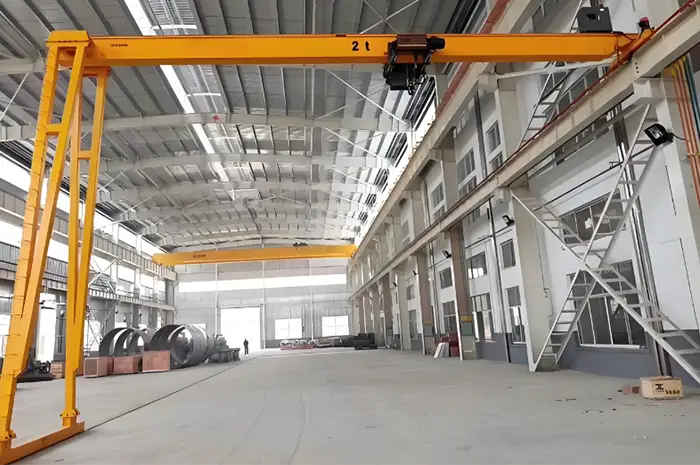
Key Features:
- Lifting Capacity: Typically available in capacities ranging from 1 ton to 10 tons, these cranes are designed to handle moderate to heavy loads with ease.
- Flexibility: The semi-gantry design offers flexibility in positioning and movement, allowing for efficient operation within confined or irregular spaces.
- Cost-Effectiveness: Compared to double girder models, single girder cranes are generally more cost-effective while still delivering reliable performance for a variety of tasks.
- Ease of Installation: The simpler design of single girder cranes often translates to easier and quicker installation compared to more complex systems.
Benefits:
- Space Efficiency: Ideal for areas with limited headroom or space constraints, single girder cranes make optimal use of available space.
- Operational Versatility: Suitable for a range of applications, from lifting machinery and materials in manufacturing settings to handling equipment in maintenance or repair tasks.
- Reduced Maintenance Costs: The straightforward design typically results in lower maintenance requirements and costs over time.
Single girder electric hoist semi-gantry cranes are popular for their efficiency and versatility in various industrial applications. Their ability to handle specific capacities makes them a preferred choice for facilities with varied lifting needs. This section explores the hot sale capacities of these cranes, highlighting their performance and suitability for different operational requirements.
Hot Sale Capacities:
- 1 Ton Semi Gantry Crane : Ideal for light-duty tasks, such as handling small components, tools, or maintenance activities. These cranes are frequently used in workshops or small manufacturing setups where space is limited and moderate lifting capacity is required.
- 2 Ton Semi Gantry Crane : Suitable for slightly heavier loads, including medium-sized machinery or bulk materials. The 2-ton capacity offers a balance between handling efficiency and space management, making it versatile for various industrial operations.
- 3 Ton Semi Gantry Crane : This capacity is commonly chosen for tasks requiring a bit more strength, such as moving larger components or equipment within medium-sized facilities. It provides the necessary power for handling more substantial loads while still maintaining a compact design.
- 5 Ton Semi Gantry Crane: Popular in many industrial settings for handling heavy machinery, large parts, or substantial materials. The 5-ton capacity provides a robust solution for a wide range of applications, including assembly lines, maintenance tasks, and more extensive manufacturing processes.
- 10 Ton Semi Gantry Crane: Used in environments that require significant lifting power, such as heavy-duty industrial operations or large-scale manufacturing. The 10-ton capacity ensures that even the heaviest loads can be managed effectively, offering both strength and reliability.
Applications:
- Manufacturing Facilities: Single girder electric hoist semi-gantry cranes with these capacities are frequently used to support various manufacturing processes, from lifting heavy components to assisting in assembly tasks.
- Maintenance and Repair: In maintenance and repair environments, these cranes handle machinery parts and equipment efficiently, ensuring that downtime is minimized and operations continue smoothly.
- Warehousing and Logistics: For facilities involved in warehousing and logistics, these cranes help in moving bulk materials and managing inventory, contributing to streamlined operations.
Conclusion: The hot sale capacities of single girder electric hoist semi-gantry cranes cover a wide range of lifting needs, from light-duty tasks to heavy-duty operations. Selecting the right capacity depends on your specific operational requirements, ensuring that you achieve optimal performance and efficiency in your industrial or manufacturing setting.
Double Girder Electric Hoist Trolley Semi-Gantry Cranes
Double girder electric hoist trolley semi-gantry cranes are known for their robust design and enhanced lifting capabilities. By incorporating two parallel horizontal beams and a semi-gantry structure, these cranes offer superior stability and load handling. This overview delves into their key features, benefits, and typical applications, highlighting why they are a popular choice for heavy-duty tasks.
Design and Structure: Double girder electric hoist trolley semi-gantry cranes are characterized by two horizontal beams that run parallel to each other. The hoist and trolley system moves along these beams, providing increased lifting height and capacity. The semi-gantry design allows the crane to support loads while straddling a portion of its operating area, making it suitable for various industrial settings.
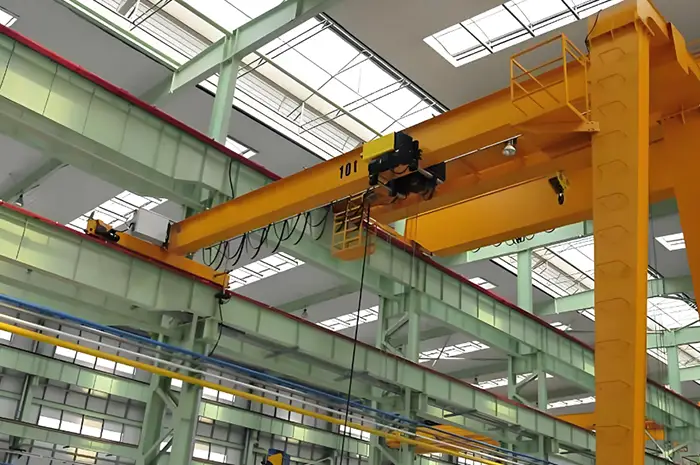
Key Features:
- Increased Lifting Capacity: With the dual-girder design, these cranes can handle larger and heavier loads compared to single girder models. Typical capacities range from 10 tons to 50 tons or more.
- Enhanced Stability: The double girder configuration provides better load distribution and stability, reducing the risk of sway and improving overall safety.
- Greater Lifting Height: The design allows for higher lifting heights, making it suitable for tasks that require substantial vertical movement.
- Versatility: Capable of handling a wide range of materials and equipment, making them suitable for diverse industrial applications.
Benefits:
- Improved Load Handling: The double girder design ensures more stable and balanced load handling, which is crucial for heavy-duty operations.
- Higher Efficiency: Provides greater operational efficiency by handling larger loads and reaching higher elevations with ease.
- Durability: Built to withstand heavy usage and harsh conditions, offering long-term reliability and reduced maintenance needs.
Double girder electric hoist trolley semi-gantry cranes are renowned for their robust design and high lifting capacities, making them essential for heavy-duty industrial operations. Their ability to handle significant loads with stability and precision is a key factor in their widespread adoption. This section delves into the hot sale capacities of these cranes, emphasizing their suitability for various demanding applications.
Hot Sale Capacities:
- 5 Ton: A popular choice for many industries, the 5-ton capacity is ideal for handling medium to heavy loads such as large machinery components or substantial materials. These cranes offer a good balance between lifting power and maneuverability, suitable for a range of manufacturing and maintenance tasks.
- 10 Ton: This capacity is commonly used for more demanding applications, including lifting heavy equipment, large assemblies, or bulky materials. The 10-ton double girder design provides increased stability and strength, making it a versatile option for extensive industrial operations.
- 15 Ton: Ideal for even heavier loads, the 15-ton capacity crane is often used in large-scale manufacturing environments or in facilities where significant lifting power is required. Its robust construction ensures that it can handle substantial weights while maintaining operational safety.
- 20 Ton: Catering to high-demand applications, the 20-ton crane is designed for lifting extremely heavy loads, such as large structural components or heavy machinery. This capacity offers the highest strength and stability, making it suitable for industries with intense lifting requirements.
Applications:
- Heavy Manufacturing: In industries where heavy components or equipment need to be moved, double girder electric hoist trolley semi-gantry cranes with these capacities are indispensable for efficient and safe lifting operations.
- Construction Sites: These cranes are used in construction sites to handle large materials and structural elements, ensuring that projects proceed smoothly and on schedule.
- Steel Mills and Foundries: For environments dealing with heavy metals and molten materials, these cranes provide the necessary lifting power and durability to manage significant loads effectively.
The hot sale capacities of double girder electric hoist trolley semi-gantry cranes cater to a wide range of heavy-duty applications, offering both high lifting capacity and enhanced stability. Selecting the appropriate capacity ensures that your crane meets the specific demands of your industrial operations, contributing to efficiency and safety in handling large and heavy loads.
Comparison and Applications
Capacity Comparison
The lifting capacity of a crane significantly impacts its performance and suitability for various applications. Here's a comparison of the capacities available for the BMH and models:
BMH European Electric Hoist Semi-Gantry Crane:
- 3.2 Ton to 20 Ton: This range accommodates lighter to moderate loads, making it suitable for general industrial use where the lifting demands are within these limits. The crane's design focuses on optimizing space, particularly in environments with restricted headroom.
Double Girder Semi-Gantry Crane:
- 5 Ton to 32 Ton: This broader capacity range includes heavier lifting options. The double girder design offers increased stability and strength, making it ideal for handling heavier and bulkier loads. This model is better suited for high-demand applications requiring robust lifting solutions.
How Capacity Affects Crane Performance and Application:
- Higher Capacity Cranes: Generally, cranes with higher capacities are built with more robust components and greater structural support. They can handle larger and heavier loads but may require more space and specialized track types for optimal performance.
- Lower Capacity Cranes: These cranes are designed for lighter loads and often feature a more compact design. They are suitable for smaller workshops and operations where space and load requirements are less demanding.
Application of Semi Gantry Cranes
Low Capacity (3.2 Ton - 10 Ton):
- Suitable for Smaller Workshops: Cranes in this capacity range are ideal for smaller workshops or facilities where lifting needs are light to moderate. They handle light to mid-weight materials efficiently and fit well in confined spaces with height restrictions.
- Light to Mid-Weight Materials: These cranes are perfect for handling smaller components, equipment, or materials in manufacturing or assembly environments.
High Capacity (16 Ton - 32 Ton):
- Heavy-Duty Applications: Cranes with capacities in this range are designed for heavy-duty tasks, such as large-scale manufacturing, construction, and industrial environments with substantial lifting demands.
- Large-Scale Manufacturing and Construction: Ideal for lifting heavy machinery, bulk materials, and other large items, these cranes provide the strength and stability needed for demanding applications.
Track Type and Duty Rating Implications
Track Type:
- Lower Capacity Cranes: Track types like P24 and P30 are commonly used with lower capacity cranes. They are sufficient for lighter loads but may not support the heavier demands of high-capacity cranes.
- Higher Capacity Cranes: For cranes with higher capacities, track types such as P43, QU70, and QU80 are recommended. These tracks provide enhanced support and durability, ensuring stability and smooth operation under heavier loads.
Work Duty Ratings:
- A3 to A6 Ratings: The work duty rating indicates the crane's operational intensity and frequency. Ratings from A3 to A6 cover a range from moderate to heavy-duty applications, influencing the crane's design and component durability. Cranes with higher work duty ratings are built to endure more frequent and intense use, making them suitable for demanding industrial environments.
Safety Considerations in Capacity Handling
Load Overload Protection:
Load overload protection is a critical safety feature integrated into semi-gantry cranes to prevent accidents associated with lifting loads beyond their rated capacity. Overloading can lead to structural failure, equipment damage, and serious injuries to operators and personnel in the vicinity. Key aspects of overload protection include:
- Load Cells and Sensors: Many modern cranes are equipped with load cells and sensors that continuously monitor the weight of the load being lifted. If the weight exceeds the predefined safe limit, the system can trigger alarms or automatically halt operations to prevent further lifting.
- Limit Switches: Limit switches are installed to stop the crane's movement when it reaches its maximum load capacity. This feature ensures that operators cannot inadvertently attempt to lift loads that exceed safe limits.
- Operator Training: Ensuring that operators are well-trained in load handling procedures is essential. They should understand the crane's capacity limitations and the importance of adhering to safety protocols. Regular training sessions can help reinforce best practices and minimize the risk of accidents.
By incorporating effective overload protection mechanisms and promoting a strong safety culture, organizations can significantly reduce the risk of accidents and enhance the overall safety of crane operations.
Regular Maintenance for Optimal Capacity:
Regular maintenance is vital to ensure that semi-gantry cranes perform at optimal capacity over time. Neglecting maintenance can lead to reduced lifting capabilities, increased risk of malfunctions, and potential safety hazards. Key maintenance practices include:
- Routine Inspections: Conducting regular inspections helps identify wear and tear, structural issues, and potential safety hazards before they escalate. These inspections should include checking hoisting mechanisms, control systems, and structural integrity.
- Lubrication and Cleaning: Proper lubrication of moving parts reduces friction and wear, extending the lifespan of the crane. Additionally, keeping the crane clean prevents debris buildup, which can interfere with its operation and performance.
- Load Testing: Performing load tests at regular intervals ensures that the crane can safely handle its rated capacity. This testing involves lifting loads close to the maximum limit to verify that the crane operates correctly and safely.
- Maintenance Records: Keeping detailed records of maintenance activities helps track the crane's performance and identify patterns in repairs. This information is valuable for scheduling future maintenance and ensuring compliance with safety regulations.
By prioritizing regular maintenance and inspections, organizations can enhance the reliability and safety of semi-gantry cranes, ensuring they continue to meet operational demands effectively. Regular maintenance not only improves performance but also prolongs the lifespan of the equipment, leading to cost savings and increased productivity in the long run.
How to Get Your Customized Semi Gantry Cranes
Introduction: Acquiring a customized semi-gantry crane involves several critical steps to ensure that the equipment meets your specific operational needs and budget. This guide outlines the key parameters needed to design a semi-gantry crane tailored to your requirements and how to obtain an accurate price for your customized solution.
Define Operational Requirements:
- Load Capacity: Determine the maximum weight the crane needs to handle, which will affect the crane's design and structural components.
- Lifting Height: Specify the required vertical lift height to ensure the crane can accommodate the height needed for your operations.
- Span Length: Measure the width of the area where the crane will operate to determine the span length between the crane's legs.
Assess Environmental Conditions:
- Operating Environment: Consider if the crane will be used indoors or outdoors, as this will impact material selection and design features such as weatherproofing.
- Temperature Extremes: If operating in extreme temperatures, specify temperature ranges to ensure the crane's components are suitable for those conditions.
- Corrosion Risks: For corrosive environments, such as coastal or chemical plants, indicate the need for anti-corrosion coatings or materials.
Determine Structural and Design Features:
- Beam Configuration: Decide between single girder or double girder designs based on your load handling needs and available space.
- Hoist Type: Choose between electric hoists or other lifting mechanisms depending on the required lifting speed and precision.
- Trolley System: Specify the type of trolley system (manual or motorized) that best fits your operational requirements.
Provide Facility Layout:
- Workspace Dimensions: Provide detailed dimensions of the workspace, including ceiling height, floor space, and any obstructions.
- Access Points: Indicate the locations where the crane will need to operate and any restrictions that might affect crane movement or installation.
Request a Detailed Quotation:
- Customization Details: Share all gathered information with crane manufacturers or suppliers to receive a customized design proposal and price estimate.
- Additional Features: Include any additional features you may require, such as remote controls, safety systems, or specialized attachments.
- Lead Time and Delivery: Discuss timelines for design, manufacturing, and delivery to ensure the crane meets your project schedule.
By providing detailed information on operational needs, environmental conditions, and facility layout, you can obtain a customized semi-gantry crane that meets your specific requirements. Requesting a detailed quotation from suppliers based on these parameters will help you get an accurate price and ensure that your crane is designed to optimize performance and safety in your unique working environment.
Contact us Now: Requesting a Detailed Quotation for Semi-Gantry Cranes
To get a detailed quotation for your customized semi-gantry crane, please provide the following information:
- Crane Type: ___ ___ Specify if you need a single girder, double girder,or specialized semi-gantry crane?
- Crane Capacity:___ ___ Indicate the required lifting capacity (in tons).
- Span: ___ ___Provide the span length (distance from rail center to rail center) in meters.
- Cantilever Requirements:___ ___ If a cantilever is needed, specify the length of the left and right cantilevers (in meters).
- Lifting Height: ___ ___State the required lifting height (underhook) in meters.
- Crane Traveling Length/Runway Length:___ ___ Provide the length of the runway or travel distance.
- Power Supply: ___ ___Indicate the power supply required (e.g., 380 volts, 50 Hz, 3-phase) or specify otherwise.
- Special Requirements: ___ ___Mention any additional features or requirements.
Providing these details will help us deliver an accurate design proposal and price estimate tailored to your needs.
Conducting a thorough capacity analysis for semi-gantry cranes offers numerous benefits that contribute to overall operational efficiency, safety, and cost-effectiveness. By understanding and tailoring crane capacity to specific load requirements, industries can optimize their workflows and ensure that equipment operates within safe limits. This analysis helps in preventing overload situations, which are a common cause of accidents and equipment failures. Moreover, a well-informed capacity strategy allows organizations to minimize downtime and maintenance costs while maximizing productivity. Ultimately, a comprehensive capacity analysis fosters a safer work environment, where both personnel and equipment can operate efficiently and effectively.
Choosing the right semi-gantry crane capacity is essential for addressing the unique demands of specific industrial applications. Each industry has its distinct requirements, and understanding these needs allows businesses to select cranes that provide the best performance for their tasks. Customizing crane capacity not only enhances efficiency but also ensures safety and reliability in operations. As industries continue to evolve and grow, investing in the appropriate crane solutions becomes vital to maintaining competitive advantages and achieving long-term success. Prioritizing capacity analysis and tailored crane designs will ultimately lead to a more productive and safe working environment.
Related Products

Latest project
150 Ton Overhead Crane Installation Feedback – Paraguay Case
QDX 150 ton overhead crane in action in Paraguay. Installation photos, video, and client feedback show performance, safety, and heavy-lifting efficiency.
Free consultation to Confirm Parameters & Specifications and Get
Latest Crane Price & Crane Rate.
- Types of overhead cranes : _______?
- Optional: Overhead travelling crane, goliath gantry crane,Slewing jib crane, Single girder or double girder crane,small portable crane or kbk crane, etc.
- Capacity of overhead crane: _______?
- Optional: 0.25ton, 0.5 ton, 1 ton, 2 ton, 3ton, 5 ton, 10 ton,15ton, 20ton, 25 ton, 30ton,35ton, up to 550ton, etc.
- Crane span & lifting height : _______?
- Crane travelling length : _____?
- Control of overhead crane:_______?
- Optional: pendant/ remote/cabin control
- Voltage supply of overhead crane:_____?
- Eg,: 380V50/60HZ,3Phase or others,etc.
- Application/usage of crane:_______?
- Eg,: Steel mill, ,injection mold, cement,stone, concrete,granite, general manufacturing, etc.
Just leave a message via the contact form and our hoist and crane engineer will contact you with in 24working hours.
Get In Touch
